



A year ago, Washington Apple Pi stunned the world with the introduction of the Washington Apple Pi Mac Bench System. * In the world of computer benchmarks, WAPMBS was "a definite mouthful," according to several anonymous authorities. When comparing it to the then-reigning champion Macintosh benchmarking package, Ziff-Davis' MacBench 4.0, many of these same authorities called it "incomparable."
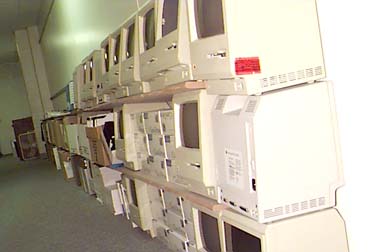 |
|
The amazing Washington Apple Pi Mac Bench System Pro, known affectionately as the "Wall of Macs." Many Pi visitors, when first encountering this impressive feat of engineering, have fled. Sad to say, even at the dawn of a new century, some people just can't accept radically linear technological advances. |
In the fall of 1998, Ziff-Davis released, too little, too late, MacBench 5.0, a foredoomed effort to catch up with WAPMBS. Foredoomed because Washington Apple Pi had already released Washington Apple Pi Mac Bench System Pro, the "Wall of Macs." We just forgot to tell anybody about it.
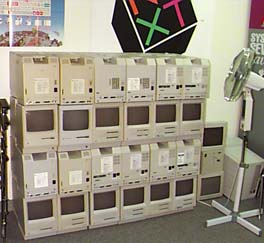 |
|
The awesome Cubemac suite is an unbelievable demonstration of parallel processing. Formed from 24 "Compact Mac" computers (an eclectic mixture of Mac 512, Mac Plus, Mac SE and Mac SE/30 machines), the Cubemac features an awesome 12,228 x 8,208 "mosaic" display, 48 serial ports, and 24 channels of monaural sound. Controlling all this is a unique operating system using NeXT "overposter" architecture that gives it the collective power of, say, a Quadra 800. Note the external cooling fan. One unprecedented capability is "autoexpansion;" a week after this photo was taken, the Cubemac had added most of another row of processors. |
WAPMBS Pro was inspired by a comment from Linus Torvalds, the creator of Linux. Microsoft Corporation, annoyed with the success of Linux (a UNIX work-alike with versions for Macs, PCs and even UNIX workstations), has been telling corporations to ignore Linux. In Microsoft's view, Linux was "created by hobbyists" and was "strictly for hobbyists," without the professional touches of Microsoft's products. Torvald's response: "If it's a hobby for us and a job for you, then why are you doing such a shoddy job?"
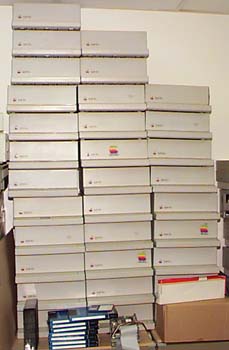 |
|
This impressive suite is another test of parallel processing. Harnessing the power of 32 Apple IIGS computers, the Tower of Apples is used to detect local geological faults. If any are found, the entire mass topples over. |
(Actually, neither Linux nor Microsoft had a thing to do with WAPMBS Pro. We just thought it was a great quote.)
After collecting some rare components (long wooden boards, to be exact), the Washington Apple Pi Mac Bench System Pro made its debut in the summer of 1998. Stretching down the main hallway of the Pi's office suite in Rockville, Maryland, WAPMBS Pro vastly exceeds the scope, depth and utility of any competitors. Compared to previous Washington Apple Pi Mac Bench Systems, WAPMBS Pro has a far vaster capacity, conservatively rated in dozens of CPUs and multiple tons. We are unaware of any other computer system that even attempts to rate itself in "tons."
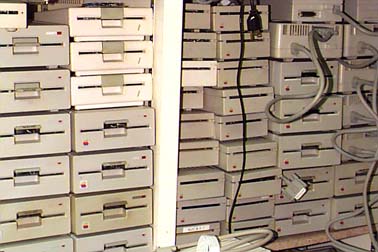 |
|
Always eager to test new computer storage options, Washington Apple Pi Labs constructed this unique disk array. We are pleased to report that virtually any new computer storage device purchased today will be faster, easier to use, and have a higher storage capacity than our array. But ours has more blinky lights. |
In its current configuration, the Pro version of our Mac Bench is a multi-processor unit capable of simultaneously holding literally thousands of Apple II and Macintosh programs. We don't mean just the software, either: it will hold the diskettes (3.5" or 5") and the documentation, too. In fact, it also has a demonstrated capacity to carry hundreds of computer magazines, Zip cartridges, Bernoulli cartridges, data cassettes and various bits of computer technology we can't immediately identify. As the Pi Office Manager, speaking anonymously, put it, "There's all kinds of ______ on it."
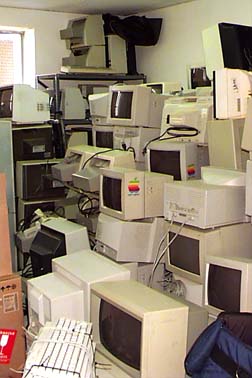 |
|
After almost a decade with relatively little progress, computer displays are finally showing some progress, with new designs for traditional video monitors as well as outstanding progress in creating inexpensive "flat panel" displays. We'd trade our entire video test facility for some of these new displays... |
Our Pro version Mac Bench can also be expanded, almost without limit. The current three-tier configuration could easily reach six tiers before hitting the roof of the hallway. Linear expansion possibilities are even greater. Without much effort at all (but with a lot more lumber), the current thirty-foot system could wrap around the walls of the entire Washington Apple Pi office suite. Again speaking anonymously, the Pi Office Manager said, "Don't even think of it."
Going faster, farther and cheaper, however, are what Washington Apple Pi's entire Mac Bench program is all about. While Ziff-Davis contents itself with dinky little CD-ROMs holding their MacBench program, we are building Mac Bench systems of ever growing capacity.
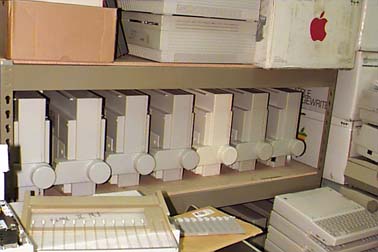 |
|
Washington Apple Pi Labs has the only vertical printer test facility in the world. Prior to Senator John Glenn's shuttle flight, we proved that a twelve-year-old ImageWriter II would work in this position. NASA, for unexplained reasons, didn't seem to care. |
And ever growing variety, too. The Mac Bench system has evolved from our original concept of a year ago to an entire suite of systems. New additions include:
Everything, of course, is fully Y2K compliant. Even the components that are 20 years old.
We'd trade it all in an instant, of course, for a couple dozen brand-new iMacs or Power Mac G3 desktops.
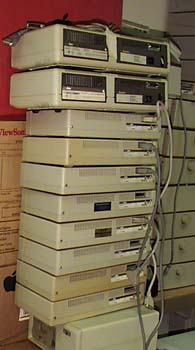 |
|
|
To be quite honest, we have no idea what this is, or what it can be used for. We were afraid to get a closer look. |
"And what do you do with this hard disk drive?" "That? That's a doorstop." |
* Introducing: Washington Apple Pi Mac Bench, Washington Apple Pi Journal, January/February 1998, pp. 25-26.
![]()
Revised December 13, 1998 Lawrence I. Charters
Washington Apple Pi
URL: http://www.wap.org/journal/